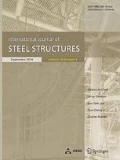Abstract
The aim of the research was to determine reliability function of net cross-section resistance in relation to accidental eccentricity of nominally centric holes. The response surface method was used by taking into account the relevant Eurocode design provisions and reliability requirements. Within the response surface method, the central composite design method and the least square method were used with the employment of Monte Carlo simulations. The probable distributed variables such as strength f y, breadth b, thickness t, diameter d 0 and eccentricity e were determined by the central composite design method. 280 different numerical simulations were set up with varying variables. A log-normal distribution for strength (f y) and a normal distribution for geometrical variables (b, t, d 0,e) were employed by taking into account the coefficients of variations: V fy=0.07, V b,=0.005, V l=0.05 and V d0=0.005. In order to determine the influence of eccentricity on partial safety factor, several normal distributions with different variation factors were applied in the analysis. The influence of the edge distance of the hole e 2 over d 0 ratio on the partial safety factor was determined by varying mean values of variable b. For comparison, two types of steel were used: structural steel S235 and high strength steel S690. Numerical simulations of the net cross-section resistance F u were performed with ABAQUS 6.7. The response surface for the net cross-section resistance was determined by introducing a quadratic approximation function and by applying the least square method. The partial safely factor was then (statistically) obtained by means of robust Monte Carlo simulations on the calculated response surface.
Similar content being viewed by others
References
Box, G. and Wilson, K. (1951). “On the experimental attainment of optimum conditions.” Journal of the Royal Statistical Society, Series B 13
CEN (2004). “Eurocode-Basis of structural design, EN 1990.” European Committee for Standardisation, Brussels.
CEN (2005). “Eurocode 3: Design of steel structures-Part 1-1: General rules and rules for buildings, EN 1993-1-1.” European Committee for Standardisation, Brussels.
CEN (2005). “Eurocode 3: Design of steel structures-Part 1-8: Design of joints, EN 1993-1-8.” European Committee for Standardisation, Brussels.
CEN (2007). “Eurocode-Execution of steel structures and aluminium strucures-Part 2: Technical requirements for the execution of steel structures-Stage 49, prEN 1090-2.” European Committee for Standardisation, Brussels.
Cheng, J. and Xiao, R.-C. (2005). “Probabilistic free vibration and flutter analyses of suspension bridges.” Engineering Structures, 27, pp. 1509–1518.
Johansson, B., Maquoi, R., and Sedlacek, G. (2001). “New design rules for plated structures in Eurocode 3.” Journal of Constructional Steel Research, 57, pp. 279–31
Mohamed, A., Soares, R., and Venturini, W. S. (2001). “Partial safety factors for homogeneous reliability of nonlinear reinforced concrete columns.” Structural Safety, 23, pp. 137–15
Može, P., Beg, D., and Lopatic, J. (2007). “Net cross-section design resistance and local ductility of elements made of high strength steel.” Journal of Constructional Steel Research, 63, pp. 1431–144
Pavlovĉiĉ, L., Detzel, A., Kuhlmann, U., and Beg, D. (2007). “Shear resistance of longitudinally stiffened panels—Part 1: Tests and numerical analysis of imperfections.” Journal of Constructional Steel Research, 63, pp. 337–35
Snijder, H. H., Ungermann, D., Stark, J. W. B., Sedlacek, G, Bijlaard, F. S. K., and Hemmert-Halswick, A. (1988a). “Evaluation of test results on bolted connections in order to obtain strength functions and suitable model factors-Part A: Results, Background report to Eurocode 3.” Eurocode 3 Editorial Group.
Snijder, H. H., Ungermann, D., Stark, J. W. B., Sedlacek, G, Bijlaard, F. S. K., and Hemmert-Halswick, A. (1988b). “Evaluation of test results on bolted connections in order to obtain strength functions and suitable model factors-Part B: Evaluations, Background report to Eurocode 3.” Eurocode 3 Editorial Group.
Soares, R. C, Mohamed, A., Venturini, W. S., and Lemaire, M. (2002). “Reliability analysis of non-linear reinforced concrete frames using the response surface method.” Reliability Engineering & System Safety, 75, pp. 1–16.
Wolfram (2008). “Mathematica 6.0, The user guide.” Wolfram Research, Inc
Wong, S. M., Hobbs, R. E., and Onof, C. (2005). “An adaptive response surface method for reliability analysis of structures with multiple loading sequences.” Structural Safety, 27, pp. 287–308.
Author information
Authors and Affiliations
Corresponding author
Rights and permissions
About this article
Cite this article
Sinur, F., Beg, D. Reliability analysis of net cross-section resistance with accidental eccentricity of holes. Int J Steel Struct 9, 153–160 (2009). https://doi.org/10.1007/BF03249490
Received:
Accepted:
Issue Date:
DOI: https://doi.org/10.1007/BF03249490




